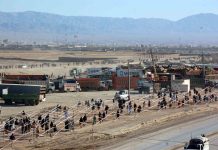LAHORE: An increase in suicide attacks in Balochistan province this year has left 230 people dead and more than 400 people injured.
Security and government officials allege the upsurge in violence is connected to resent over the newly-opened China-Pakistan Economic Corridor (CPEC) from Pakistan’s regional rivals, particularly India.
Independent analysts however doubt the government’s arguments.
“The emergence of Gwadar as a functional deep sea port is definitely not a good news for several regional and international powers,” Wajahat Masood, a Lahore-based analyst told Truth Tracker.
“India and Iran, being contiguous stakeholders, are obvious contenders in the economic race.”
He says the UAE, being a trade-centric state, has every reason to feel the heat exuding from each ship cruising from or to Gwadar coast. However the suicide attacks in Balochistan are more likely to be part of the sectarian conflict that has plagued Pakistan for decades.
“The flip side of the coin is the fact that terrorism in Pakistan didn’t originate with the emergence of the CPEC project. It has long been there as a direct result of the state narrative pursued by the state of Pakistan. The terrorist incidents in recent months carry an unmistakable sectarian miasma,” Masood said.
On August 8, 95 people were killed in a suicide blast outside the Quetta hospital. The army’s Inter-Services Public Relations (ISPR) issued a press release blaming the attack on an attempt to undermine the improved security situation of Balochistan, specifically targeting the CPEC. Similar statements have been issued by Prime Minister Nawaz Sharif, Defence Minister Khwaja Asif and Balochistan Chief Minister Sanaullah Zahri. They point fingers at long-time rival neighbour India, directly or indirectly.
The corridor set the bells ringing after Chinese Premier Li Kequiang visited Pakistan in April 2015 and announced the project.
“If you see the number of suicide attacks targeting Balochistan, it shows a hike in 2016 as compared to 2015, when only one suicide attack occurred, and it shows the new target is Balochistan, the focal point of the CPEC,” said retired Brigadier Aamir Gillani, who had served in Balochistan for the last five years.
On July 17 last year, two people were killed in a suicide explosion near Sardar Bahadur Khan Women’s University on Brewery Road. The attack was of a sectarian nature.
“The nature of the attacks occurring in 2016, however, show that attacks are aimed at security forces and the general public, only to harm the CPEC,” Zohrab Khan Bughti, a police officer of the Balochistan Police told News Lens.
Suicide attackers opened 2016 with a deadly blast in January on Satellite Town in Quetta where 15 people, including 13 police personnel and a soldier, were killed and 25 others injured. The target was a hospital. Two weeks later a suicide bomber claimed the lives of six Pakistan Army personnel near the cantonment area of Zhob district.
On February 3 in Kalat one of the three would-be suicide bombers detonated the explosives he was wearing. Three days later, a suicide bomber detonated himself near a Frontier Corps (FC) picket at Multan Chowk in Quetta, killing 12 people, including four FC officials, and injuring another 38 people.
The deadliest attack occurred on August 8, when 95 people were killed and another 100 others were injured outside the Quetta’s Civil Hospital. The bomber hit the crowd mourning the death of Balochistan Bar Association President Bilal Anwar Kasi, who was killed in a gun attack just hours earlier.
Another deadly blast followed, which killed 61 police personnel while 164 others were injured at a police training school at New Sariab on October 24. On November 12, 60 people were killed in a suicide blast at the Shah Noorani shrine in Hub.
Veteran journalist and an expert on Balochistan Rashed Rehman also refutes efforts to blame the attacks on India.
“The allegation that the insurgency in Balochistan is purely India-driven is oversimplification to the point of absurdity. This is a charge that has been used to castigate every previous insurgency in the province as well,” Rehman told News Lens.
“Although no proof is available for the charge, even if for the sake of argument it is accepted, is it not axiomatic that the foreign hand can only fish in troubled waters?”
The government meanwhile is implementing extraordinary measures for CPEC security.
According to figures shared by an official of the Balochistan home department with News Lens on the condition of anonymity, 9,000 army personnel and 6,000 civil armed forces had been deployed for the CPEC security.
Another visible security measure for the CPEC involving huge allocations is the creation of the Gwadar Security Task Force. The force has been placed under the command of a brigadier. The federal government and the Balochistan government are bearing the cost.
The skyrocketing figures for the CPEC security came from Finance Minister Ishaq Dar. He said in a news briefing in May that Rs 100bn expenditure on security, not included in the fiscal deficit ceiling, would be generated again this year.
“One per cent of the Chinese investment will be spent on security of the project,” CPEC project director Maj Gen (retired) Zahir Shah told a parliamentary committee in July.
The CPEC was heralded as a game changer for the Pakistan economy. So far, its security cost has taken its toll on Balochistan, power consumers and the public.



